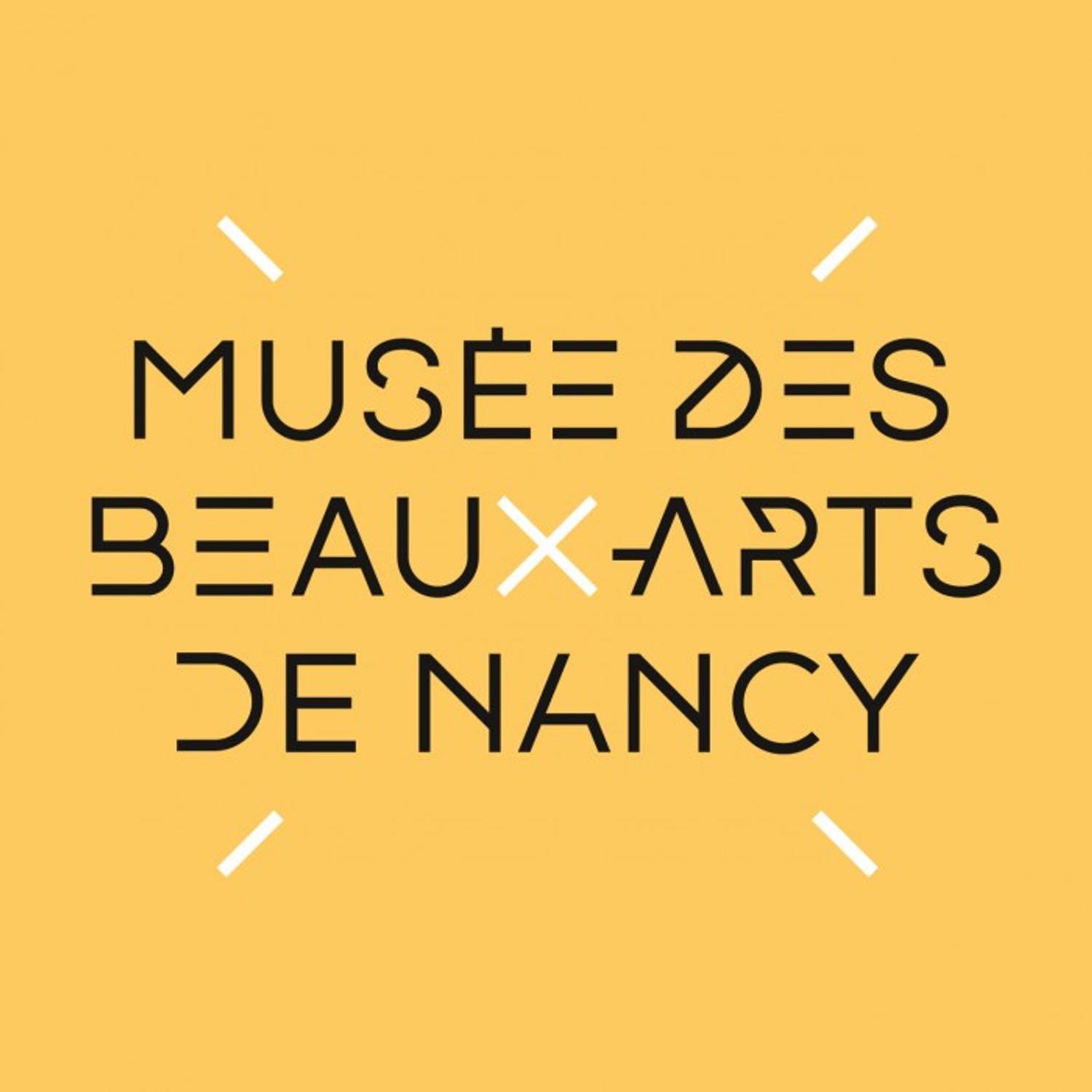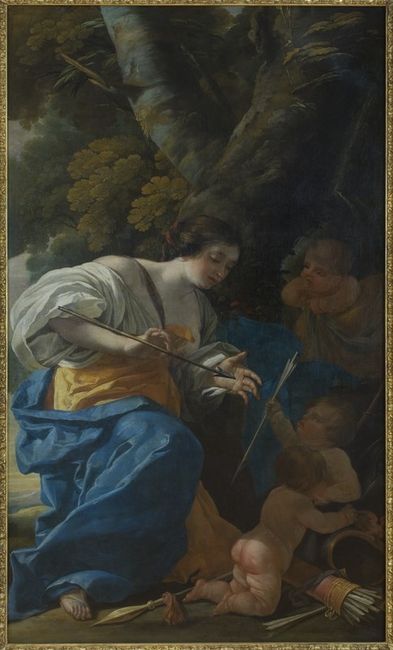Nymphe essayant les flèches de l'Amour - Vouet Simon
Domaine
Peinture
Peintre
Vouet Simon
- Lieu de naissanceParis
- Date de naissance1590
- Lieu de décèsParis
- Date de décès1649
- Notice biographiqueFrench painter and draughtsman. Although at the time regarded as one of the leading French painters of the first half of the 17th century, he is now known more for his influence on French painting than for his actual oeuvre. He made his reputation in Italy, where he executed numerous portraits for aristocratic patrons and was commissioned for religious subjects. Although the early Italian works show the influence of Caravaggio, his work was subsequently modified by the Baroque style of such painters as Lanfranco and the influence of the Venetian use of light and colour. When he was summoned back to France by Louis XIII in 1627 he thus brought with him an Italian idiom hitherto unknown in France that revitalized French painting (see France, §III, 3). His style became highly popular among Parisian aristocrats who saw in Vouet a painter capable of decorating their hôtels and châteaux in a manner that would rival the palazzi of their Italian counterparts. He quickly established a large workshop through which passed many of the leading French painters of the mid-17th century. There followed numerous commissions for allegorical works, religious subjects and decorative paintings for royal residences and the burgeoning hôtels and châteaux in and around Paris. The schemes introduced a new type of illusionistic decoration with steep perspective that influenced a generation of decorative painters. Few of his canvases are signed and dated and many of his decorative schemes have been destroyed; precise attribution is made more difficult because of his prolific output and his extensive use of his workshop to fulfil his numerous commissions. Although much of his oeuvre has been lost, it is known from the work of such distinguished engravers as Claude Mellan and Michel Dorigny, who reproduced and circulated his work.
1. Early years and Italy, 1590–mid-1627.
Little is known of his early life, except for the fact that his father, Laurent Vouet (b c. 1553–8), was a Parisian painter. Félibien records that he travelled to England at the age of 14 to ‘make the portrait of a Lady of quality’, and left for Constantinople in 1611, under the auspices of the King’s Ambassador, in order to execute the portrait of a ‘Grand Seigneur’. It was thus his talent as a portrait painter that brought him recognition. In 1612 he left Constantinople for Venice and by 1614 he was in Rome, where he received a pension from the French crown and enjoyed the protrection and patronage of the Barberini family. He rapidly established a reputation and received numerous commissions from ecclesiastical and aristocratic patrons, among them Cassiano dal Pozzo, Vincenzo Giustianini, Paolo Giordano Orsini and the Doria family, whom he depicted in such portraits as that of Gian Carlo Doria (Paris, Louvre).
Vouet became part of the Caravaggist movement (see Caravaggio, michelangelo merisa da, §IV, 1), which flowered in the 1620s and involved artists of all nationalities working in Rome. He worked on such themes as Judith with the Head of Holofernes (Vienna, Ksthist. Mus.), David with the Head of Goliath (Genoa, Pal. Bianco), The Fortune-teller (Ottawa, N.G.) and St Jerome and the Angel (Washington, DC, N.G.A.). The presentation of life-size figures on a plain background, the dramatic contrasts of light, the realistic anatomical studies drawn from life and the lack of any attempt to achieve a decorative layout were part of the language of Caravaggio. Several of Vouet’s great religious works executed for churches in Rome, such as the Temptation of St Francis (Rome, S Lorenzo in Lucina), also show the influence of Caravaggio in their presentation of effects of light and their use of a restricted palette of blacks, browns and whites. He also continued to work in a personal style, and was familiar not only with the great examples of the first and second schools of Fontainebleau but also with the great Venetian artists of the 16th century. The Fortune-teller, for example, is a fine illustration of a Caravaggesque genre scene but its burlesque treatment is quite alien to the Caravaggesque spirit.
Vouet also travelled in Italy. In 1621 he was in Genoa, where he painted portraits of Marcantonio Doria (Paris, Louvre) and Donna Isabella Appiana, Princess of Piombino (lost). He was impressed by the Circumcision (1606) by Rubens in Sant’Ambrogio, Genoa, and saw the work of the great artists of Bologna. He also saw such northern artists as Gerrit van Honthorst, and such contemporary Italian painters as Giovanni Lanfranco, Bartolomeo Manfredi, Orazio Borgianni, Bernardo Strozzi (1581–1644), Orazio Gentileschi and Artemisia Gentileschi.
His letters express his admiration of fine collections and his eagerness to explore Piacenza, Parma, Bologna and Florence, which he probably visited on his way back to Rome. During the years in Italy Vouet executed numerous portraits, with broad brushstrokes, in which the model is captured from life, the mouth slightly open and the head and shoulders turned towards the spectator, e.g. ?Self-portrait (Arles, Mus. Réattu), Portrait of a Young Man (Paris, Louvre) and Portrait of a Bravo (Brunswick, Herzog Anton Ulrich-Mus.). He produced a considerable number of religious paintings: Circumcision (1622; Naples, Sant’Angelo a Segno), the Appearance of the Virgin to St Bruno (?1626; Naples, Mus. N. S Martino), the Apotheosis of St Theodore (Dresden, Alte Pin.) for the Scuola di San Teodoro, Venice, Birth of the Virgin (c. 1620; Rome, S Francesco a Ripa; see fig. 1), the Clothing of St Francis and the Temptation of St Francis (both 1624; Rome, S Lorenzo in Lucina, Alaleoni Chapel). In the Birth of the Virgin, the dramatic side lighting that makes the figures stand out against the dark background, the di sotto viewpoint, the plastic appearance of the figures and the gravity of the faces all reflect Vouet’s thoughtful contemplation of Caravaggio’s work, making this painting an exceptional piece from his Roman period. The linked series of gestures, the fullness of the draperies, the delicacy of the colour harmony and the care taken to achieve an elegant effect were already characteristic of Vouet’s work, which, at this period, still retained a breath of lyricism.
The Clothing of St Francis commissioned by Paolo Alaleone represents another stage in Vouet’s development. Although the presentation of the characters’ psychological reactions recalls Caravaggio, the attention paid to the narrative does not, and the decorative arrangement and lighting contrasts recall the artists of Bologna and Lanfranco. Vouet subsequently often adopted the decorative option seen here, setting his scene on a staircase with a background of columns, and this colour palette grew lighter. The Temptation of St Francis was a daring and singular work; commissioned for a church, in its dancing figure of a courtesan and its candlelit illumination it recalls the work of Honthorst, and the highly realistic treatment of detail is one of the lasting influences of his stay in Italy. Much of his Roman oeuvre was engraved by Claude Vignon, Johann Freidrich Greuter (c. 1600–60) and Claude Mellan.
Vouet’s advice to Mellan was ‘to draw and to set this study above all others’; it is therefore certain that he continued to develop his drawing skills in Italy. Very few of his drawings from his Italian period have survived, however, although numerous drawings from his Parisian period (e.g. Study for a Figure of Intellect; see fig. 2), mainly executed in black chalk highlighted with white, show a considerable debt to Italian draughtsmen, in particular Annibale Carracci, Domenichino and some of the Genoese artists. The study (Reims, Mus. St-Denis) for part of the Allegory of the House of Savoy, engraved by Mellan, and St Peter Healing the Sick with his Shadow (Princeton U., NJ, A. Mus) are among the few extant Italian drawings. The second, executed in wash over an outline in black chalk, is of particular interest as it appears t
Date de création
1635 : vers
Désignation du bien
Nymphe essayant les flèches de l'Amour
Libellé
Huile sur toile
Mesures
H. en cm : 187
L. en cm : 137
H. avec le cadre en cm : 227
L. avec le cadre en cm : 154
Epaisseur avec le cadre en cm : 10
Poids en kg : 80
Bibliographie
Catalogue des tableaux et statues exposés au musée de Nancy, Nancy, 1825
Catalogue des tableaux et statues exposés au musée de Nancy, Nancy, 1825
n°72
Musée de Nancy, Tableaux, Dessins, Statues & Bas-reliefs, Descriptif annoté, 1897
Musée de Nancy, Tableaux, Dessins, Statues & Bas-reliefs, Descriptif annoté, 1897
n°529
Musée de Nancy, Tableaux, dessins, statues & objets d'art. Catalogue descriptif et annoté, Nancy, 1909
Musée de Nancy, Tableaux, dessins, statues & objets d'art. Catalogue descriptif et annoté, Nancy, 1909
n°583
Claude Pétry, Le Musée des Beaux-Arts de Nancy, Coédition Musées et monuments de France, Ville de Nancy et Albin Michel, Nancy, 1989
Claude Pétry, Le Musée des Beaux-Arts de Nancy, Coédition Musées et monuments de France, Ville de Nancy et Albin Michel, Nancy, 1989
n°583
Claude Pétry, Le Musée des Beaux-Arts de Nancy, Coédition Musées et monuments de France, Ville de Nancy et Albin Michel, Nancy, 1989
Claude Pétry, Le Musée des Beaux-Arts de Nancy, Coédition Musées et monuments de France, Ville de Nancy et Albin Michel, Nancy, 1989
p.52
Blandine Chavanne (dir.), Eclats : Collection du musée des Beaux-arts de Nancy, Somogy, 2005
Blandine Chavanne (dir.), Eclats : Collection du musée des Beaux-arts de Nancy, Somogy, 2005
p. 88, ill.
Exposition
n°32, p.259 à 261.
Cat. exp. 1990-1991, Paris, Galeries nationales du Grand Palais, 6 novembre 1990 - 11 février 1991, Vouet, sous la direction scientifique de Jacques Thuillier.
Charles Dauphin : un tableau redécouvert, Nancy, Musée des Beaux-Arts, 15 juillet - 23 novembre 2015
Acquisition
2008 Transfert de propriété Etat
Notes
Dépôt de l'Etat du 26 avril 1801, transfert de propriété de l'Etat à la ville de Nancy, 2008
Photographe
Cliché Michel Bourguet
Numéro d'inventaire
275
Sujet / thème
Mythologie
Nymphe
Personne représentée
Amour
Facettes
Cliquez sur un terme pour voir toutes les œuvres de nos collections associées à ce dernier.












